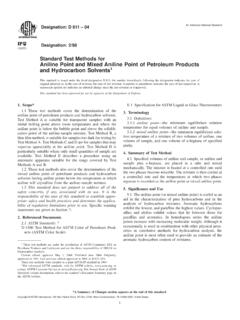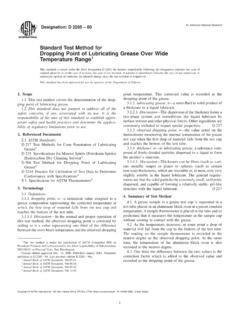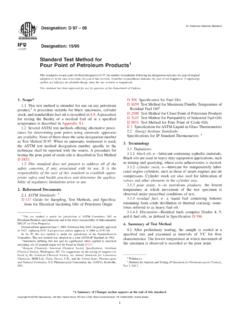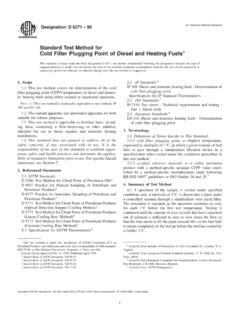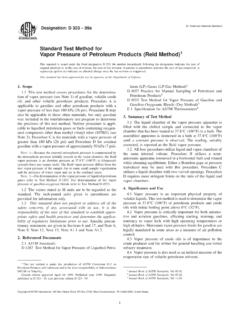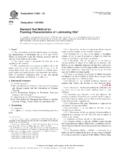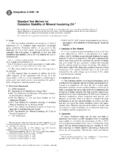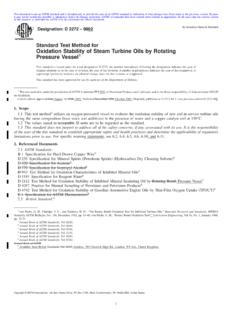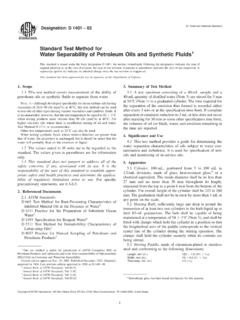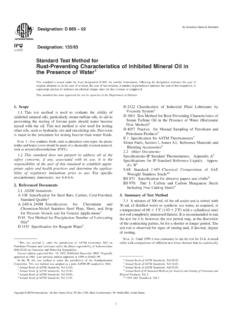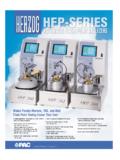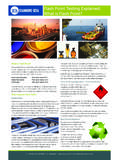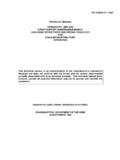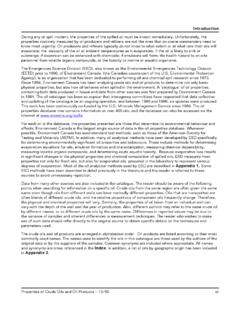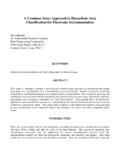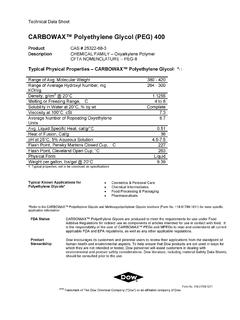Transcription of Standard Test Methods for Flash Point by Pensky-Martens ...
1 Designation: D 93 02aDesignation: 34/99An American National StandardStandard Test Methods forFlash Point by Pensky-Martens closed Cup Tester1 This Standard is issued under the fixed designation D 93; the number immediately following the designation indicates the year of originaladoption or, in the case of revision, the year of last revision. A number in parentheses indicates the year of last reapproval. A superscriptepsilon (e) indicates an editorial change since the last revision or Standard has been approved for use by agencies of the Department of Flash Point test method is a dynamic test method and depends on definite rates of temperatureincreases to control the precision of the test method.
2 The rate of heating may not in all cases give theprecision quoted in the test method because of the low thermal conductivity of certain materials. Toimprove the prediction of flammability, Test Method D 3941, an equilibrium method, was developedin which the heating rate is slower. This allows the vapor above the test specimen and the testspecimen to be at about the same temperature. If your specification requires Test Method D 93, do notsubstitute Test Method D 3941 or any other test method without obtaining comparative data andagreement from the Point values are a function of the apparatus design, the condition of the apparatus used, andthe operational procedure carried out.
3 Flash Point can therefore only be defined in terms of a standardtest method, and no general valid correlation can be guaranteed between results obtained by differenttest Methods , or with test apparatus different from that Scope * These test Methods cover the determination of the flashpoint of petroleum products in the temperature range from 40to 360 C by a manual Pensky-Martens closed -cup apparatus oran automated Pensky-Martens closed -cup Flash Point determination as above 250 C can be performed,however, the precisions have not been determined above this residual fuels, precisions have not been determined for Flash pointsabove 100 Procedure A is applicable to distillate fuels (diesel,kerosine, heating oil, turbine fuels)
4 , new lubricating oils, andother homogeneous petroleum liquids not included in the scopeof Procedure Procedure B is applicable to residual fuel oils, cutbackresidua, used lubricating oils, mixtures of petroleum liquidswith solids, petroleum liquids that tend to form a surface filmunder test conditions, or are petroleum liquids of such kine-matic viscosity that they are not uniformly heated under thestirring and heating conditions of Procedure These test Methods is applicable for the detection ofcontamination of relatively nonvolatile or nonflammable ma-terials with volatile or flammable The values stated in SI units shall be regarded as thestandard.
5 The values given in parentheses are provided forinformation Standard does not purport to address all of thesafety concerns, if any, associated with its use. It is theresponsibility of the user of this Standard to establish appro-priate safety and health practices and determine the applica-bility of regulatory limitations prior to specific hazardsstatements, see , , , , , , and Referenced Standards:D 56 Test Methods for Flash Point by Tag closed CupTester2D 3941 Test Method for Flash Point by the EquilibriumMethod with a closed -Cup Apparatus3D 4057 Practice for Manual Sampling for Petroleum andPetroleum Products41 These test Methods are under the joint jurisdiction of ASTM Committee D02 onPetroleum Products and Lubricants and are the direct responsibility of Subcommit-tee on Volatility.
6 In the IP, these test Methods are under the jurisdiction ofthe Standardization edition approved Dec. 10, 2002. Published March 2003. Originallyapproved in 1921. Last previous edition approved in 2002 as D 93 Book of ASTM Standards, Vol Book of ASTM Standards, Vol Book of ASTM Standards, Vol *A Summary of Changes section appears at the end of this ASTM International, 100 Barr Harbor Drive, PO Box C700, West Conshohocken, PA 19428-2959, United 4177 Practice for Automatic Sampling of Petroleum andPetroleum Products4E 1 Specification for ASTM Thermometers5E 300 Practice for Sampling Industrial Chemicals6E 502 Test Method for Selection and Use of ASTM Stan-dards for the Determination of Flash Point of Chemicals byClosed Cup Standards8 Guide 34 Quality Systems Guidelines for the Production ofReference MaterialsGuide 35 Certification of Reference Material General andStatistical Principles3.
7 ,adj in petroleum products the conditionwhere the vapor above the test specimen and the test specimenare not in temperature equilibrium at the time that the ignitionsource is This is primarily caused by the heatingof the test specimen at the constant prescribed rate with thevapor temperature lagging behind the test specimen ,n in petroleum products the conditionwhere the vapor above the test specimen and the test specimenare at the same temperature at the time the ignition source This condition may not be fullyachieved in practice, since the temperature may not be uniformthroughout the test specimen, and the test cover and shutter onthe apparatus can be Point ,n in petroleum products, the lowesttemperature corrected to a barometric pressure of kPa(760 mm Hg)
8 , at which application of an ignition source causesthe vapors of a specimen of the sample to ignite under specifiedconditions of The test specimen is deemed to haveflashed when a flame appears and instantaneously propagatesitself over the entire surface of the test When the ignition source is a testflame, the application of the test flame may cause a blue haloor an enlarged flame prior to the actual Flash Point . This is nota Flash Point and shall be Summary of Test A brass test cup of specified dimensions, filled to theinside mark with test specimen and fitted with a cover ofspecified dimensions, is heated and the specimen stirred atspecified rates, by either of two defined procedures (A or B).
9 An ignition source is directed into the test cup at regularintervals with simultaneous interruption of the stirring, until aflash is detected (see ). The Flash Point is reported asdefined in Significance and The Flash Point temperature is one measure of thetendency of the test specimen to form a flammable mixturewith air under controlled laboratory conditions. It is only oneof a number of properties which must be considered inassessing the overall flammability hazard of a Flash Point is used in shipping and safety regulations todefineflammableandcombustiblematerials .
10 One should con-sult the particular regulation involved for precise definitions ofthese The Department of Transportation (DOT)9and of Labor (OSHA) have established that liquids with a flashpoint under C (100 F) are flammable, as determined by these testmethods, for those liquids which have a kinematic viscosity of mm 2/s(cSt) or more at C or mm 2/s (cSt) or more at 25 C (77 F), or thatcontain suspended solids, or have a tendency to form a surface film whileunder test. Other classification Flash points have been established by thesedepartments for liquids using these test These test Methods should be used to measure anddescribe the properties of materials, products, or assemblies inresponse to heat and an ignition source under controlledlaboratory conditions and should not be used to describe orappraise the fire hazard or fire risk of materials, products, orassemblies under actual fire conditions.
